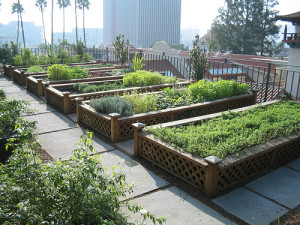Everyone must have been to or at least heard of Manhattan, New York. Manhattan is so developed and crowded that it is extremely hard to put any new building into the area. One day, some New Yorkers had this crazy idea: how nice it is going to be if I can buy vegetables that are produced five blocks away. There were only two solutions to this problems: blow up some buildings to make space for the fields, or, to build a vertical farm.
What is a vertical farm. Vertical farms are farms that are built in building. It is still a concept, which means there is large scale vertical farm in the world (there are some small ones for experiments). It stays as a concept due to a lot of technological reasons such as how to provide light for the plants inside the building and details about planting and harvesting.
People are trying to achieve vertical farming through different ways, for example, in Sweden, plants travel on lines from the top of the building to the bottom of it, and this design will make the receiving of sunlight and harvesting easier. The one in Sweden is a simple form of vertical farming, but not an actual vertical farm.
Professor Dickson Despommier came up with this idea in 1999. He and his students are studying it to develop sustainable food production and protect the environment. Crops like corns, wheats, bananas, and coconuts are desirable products to be grown in vertical farms. Surprisingly, vegetables are not the only target objects in a vertical garden. Theoretically, poultry, fish, crustacean and molluscs can also be raised in a vertical garden because they only take a small space.
Vertical farms have a lot of advantages that traditional farming does not have. Firstly, by stretching farms vertically, vertical farms can fully use the area in big cities. Secondly, vertical garden can reuse the sewage and other waste in the city as its resources. Thirdly, half a million square miles of new farmland was created during the time period from 1980 to 2000, and that cause a problem to the environment.
So why is this concept not really developed through the years? There are issues behind the idea. First and the most important reason is that vertical farming makes farming more complicated. Another reason is that according to the plan of Dr. Despommier, just a prototype of a vertical farm will cause $20 to $30 million dollars.
I think it is still important to build vertical farms. The most important reason will be to protect the environment as thousands of acres of trees are being destroyed everyday just for farmlands. Also, as the population keeps growing, one day human will need to find a way to provide more food for the bigger population, and when we can not expand horizontally, we expand vertically. The crazy cost of vertical farm seems to be the biggest obstacle for its development and application, but as the technology improves, it is almost for sure that some day vertical farming will become real.
Or, we can just build a small garden on the rooftop of our buildings. That will make everything easy.

Sources
https://vertigrowers.wordpress.com/2013/03/26/peter-platts-interview-with-the-father-of-vertical-farming/
http://news.stanford.edu/news/2010/september/farmland-cutting-forests-090210.html
http://www.wsj.com/articles/SB10000872396390443855804577602960672985508
https://sites.google.com/site/icecairowiki/projects/urban-rooftop-gardening


The cool picture of the building with the vertical farm got my attention. You listed all these valid cons against vertical farming such as the tremendous cost and the first thing I thought of was what if the fruits and vegetables fell off and got damaged. Anyways, my reason is not a legit reason to be against vertical farming. But the idea of vertical farming seems very intriguing and futuristic. If we can reduce deforestation and save trees, then why not? I think a consequence of vertical farming is that you will see a migration of farmers from the countryside to the cities. The farmers who choose to stay in the country will have to compete with the city farmers and that will be tough since city farmers’ products will be in close proximity to the millions of people in the city.
I have never heard of this in my life but it is so interesting! I think it looks really funny and it would be really funny looking in a crazy busy city like NYC! Around me there are tons of farms and places to grow veggies, so i can not impinge not being able to go to a framers market and pick up fresh food. i wish that this was not so expensive so that it would be more realistic.
Vertical farming seems like a good idea in theory, but the practicality of it is in doubt. Space is at such a premium in cities that a method to incorporate vertical farms into already existing buildings would have to be developed. While I do believe that rooftop gardens are an important step in the right direction of sustainability, I think it is going to take a lot more food than they will produce to feed the booming population. So the question stands, how can we take these two ideas and mix them together to create a farm system that works along with our existing infrastructure?
I had never even heard of such topic and I am glad you decided to write about it. I come from a very huge city where a farm is not just down the road however, we do have farmers markets which allow for the access of getting fresh hand picked fruit. The idea of vertical farming seems like a highly unlike method to achieve this especially with our ever growing population. I think the best idea is just to go with roof top gardens.